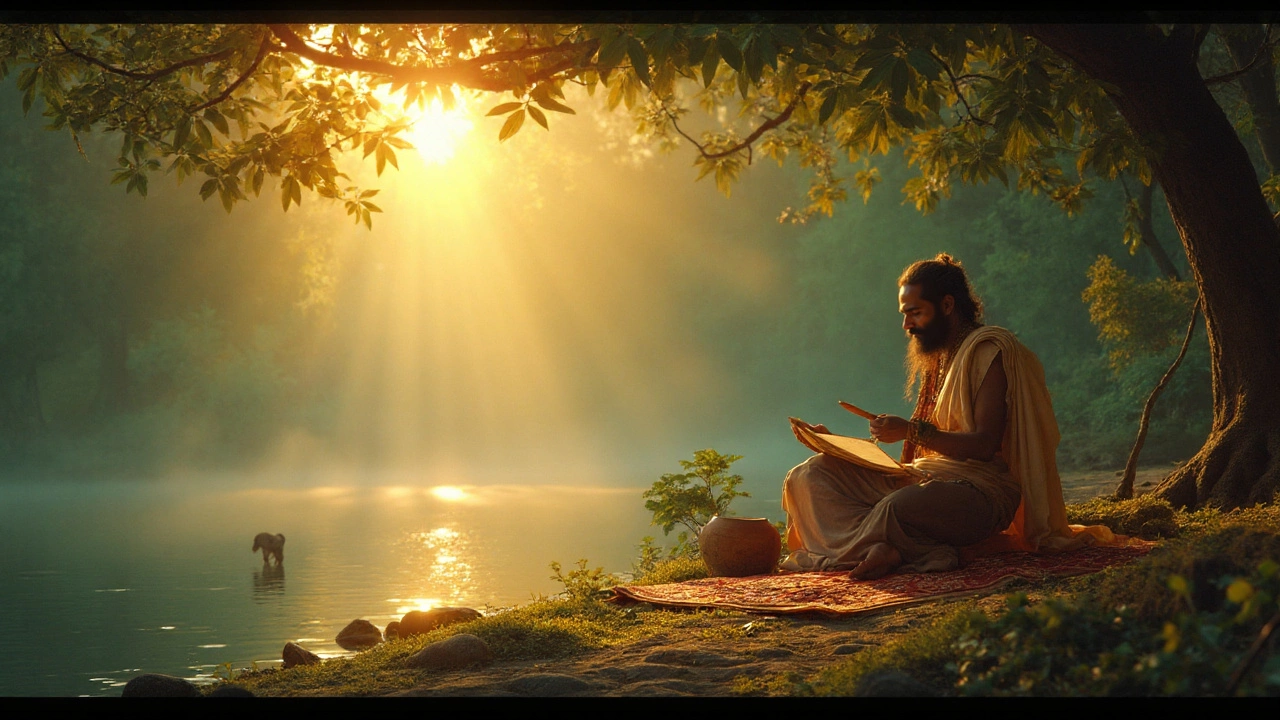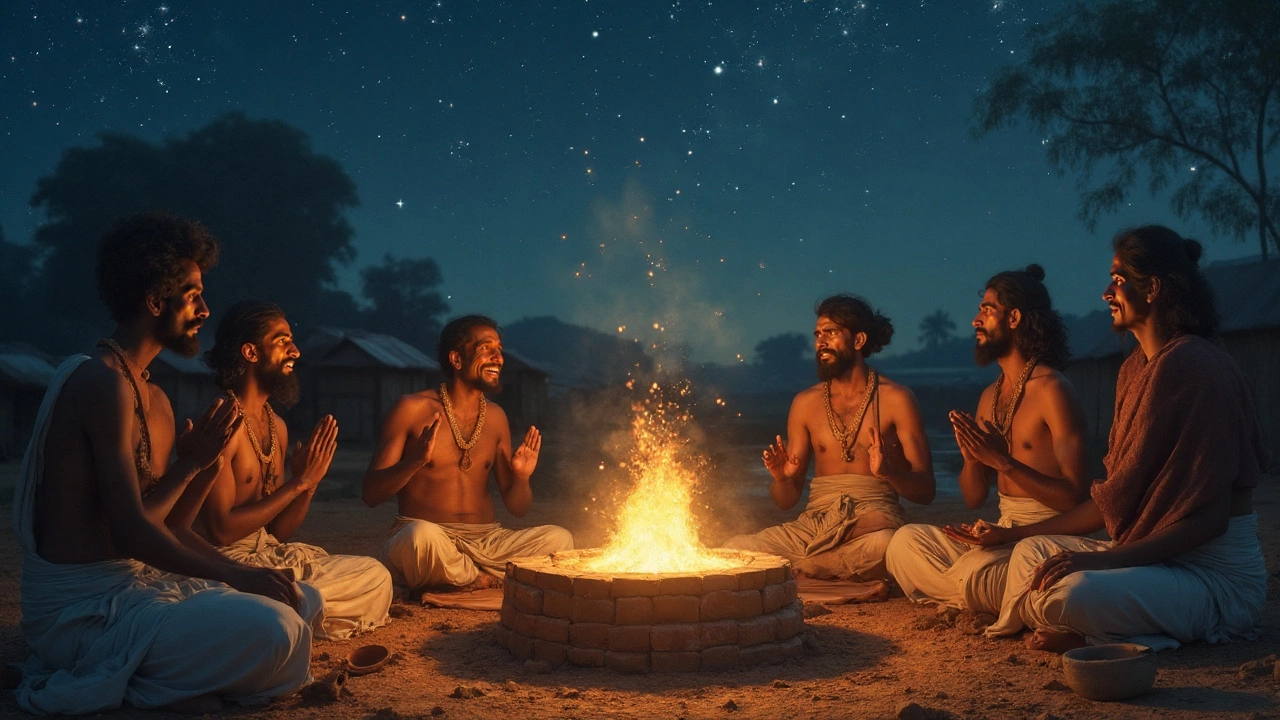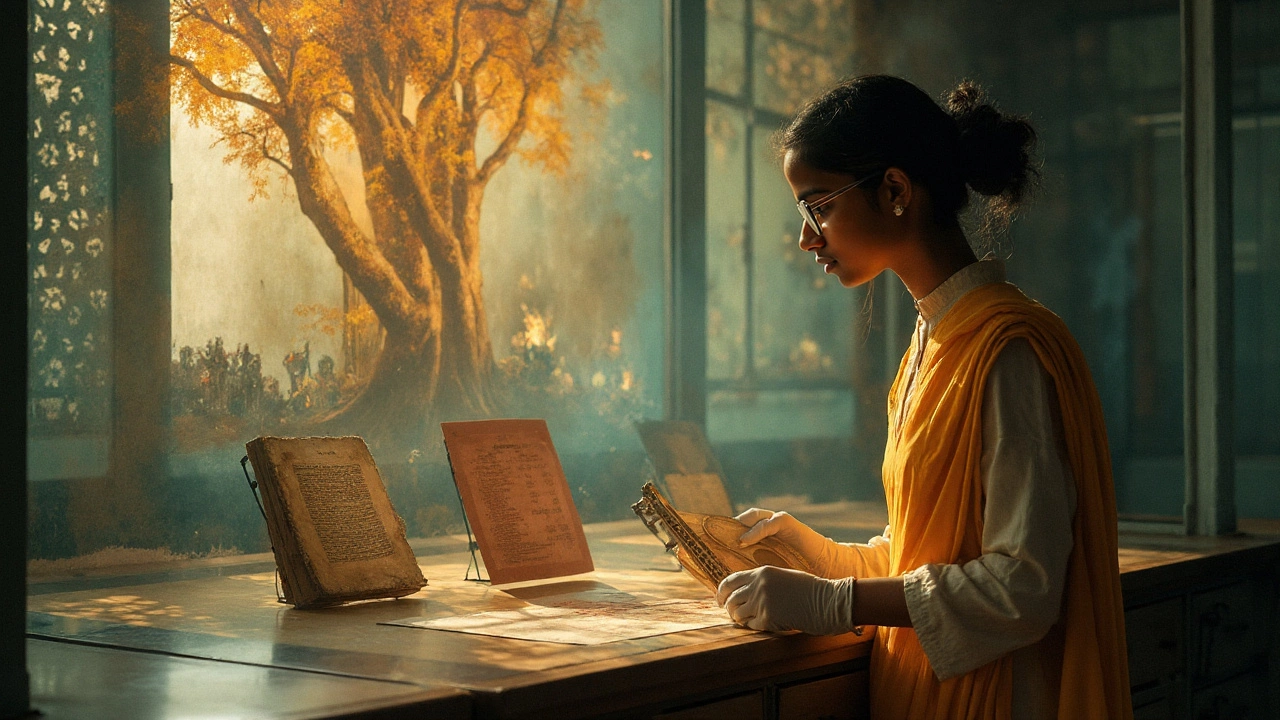Who Is the First Poet of India? Valmiki, Rigveda, and Early Indian Poetry
 Sep, 8 2025
Sep, 8 2025
You clicked to get a straight answer, and I’ll give you one. The traditional answer is Valmiki, called the Adi Kavi-the first poet-because the Ramayana’s opening couplet is celebrated as the first structured shloka in Sanskrit. But if you’re asking about the oldest poetry created in India, that’s older: the Rigveda hymns. So the “first” depends on what you mean-first by title, first surviving poem, or first in a regional language like Tamil.
- TL;DR: Valmiki is traditionally the Adi Kavi. The Rigveda is the oldest surviving Indian poetry (c. 1500-1200 BCE). In Tamil, early Sangam poets like Kapilar and Avvaiyar are among the earliest known.
- Use this in exams: Say “Valmiki, the Adi Kavi,” unless the question asks for the oldest poetry, then say “Rigveda hymns.”
- For interviews: Add a one-line nuance-“Tradition says Valmiki; historically, the Rigveda is earlier.”
- For Tamil-specific questions: Say “Sangam poets; earliest surviving corpus dates roughly 300 BCE-300 CE.”
The clear answer-and why it’s tricky
When people ask “Who is the first poem in India?” they usually mean “Who is the first poet of India?” In most school books and general knowledge quizzes, the expected answer is Valmiki. He’s honored as Adi Kavi because of a famous origin story: he sees a hunter shoot a bird, grief turns into rhythm, and he utters a verse-the first shloka. That moment is remembered as the birth of classical Sanskrit verse.
But “first” is a loaded word. India has many languages and very old oral traditions. If you define “first” as the oldest known poetry, the Rigveda’s hymns are earlier than Valmiki’s Ramayana. If you define “first” as the earliest poet with a living, named authorship tradition in Sanskrit epic literature, you land on Valmiki. If you focus on Tamil, you’ll point to Sangam poets. So the honest answer depends on context.
Here’s a simple rule of thumb you can keep handy:
- Traditional/cultural title: first poet of India → Valmiki (Adi Kavi).
- Oldest surviving Indian poetry: Rigveda hymns (multiple seer-poets).
- Earliest Tamil poetry: Sangam corpus (Kapilar, Avvaiyar, and others).
How different traditions answer “first”
India’s literary history isn’t a straight line-it’s a braided river. Different traditions give different “firsts,” and all of them are meaningful in their lane.
1) Vedic Sanskrit (Rigveda)
The Rigveda is the oldest surviving Indian poetic corpus. Composed in archaic Sanskrit and transmitted orally for centuries, it likely took shape between c. 1500-1200 BCE (some scholars stretch dates earlier or later). The hymns are attributed to many rishis (seers), not one poet. That makes it hard to crown a single “first.” Notably, women like Lopamudra, Ghosha, and Apala have hymns attributed to them in the Rigveda-proof that early Indian poetry had female voices too.
So if your question is “What is the first poem in India?” it’s safer to say “Vedic hymns from the Rigveda” rather than pick one hymn. The Nasadiya Sukta (10.129), a creation hymn, often gets spotlighted because of its striking philosophical tone, but it’s not necessarily the first composed-just one of the most discussed.
2) Classical Sanskrit epic (Valmiki)
Valmiki’s Ramayana marks a shift: a single, named poet composing a massive kavya (poem) with a consistent metrical style. Tradition calls him Adi Kavi, the first poet, and the Ramayana the first kavya. The key is the form-the Ramayana works in shloka meter (often anushtubh), which becomes the backbone of Sanskrit poetry. The origin story ties rhythm, emotion, and ethical shock into verse-poetry as a response to the world.
Dating Valmiki is tricky. The Ramayana’s core may be older, but much of the text likely took shape between c. 5th-1st century BCE, with layers added over time. Even with these layers, the cultural memory places Valmiki at the start of Sanskrit kavya tradition.
3) Classical Tamil (Sangam)
The earliest surviving Tamil poems come from the Sangam corpus (Eight Anthologies and Ten Idylls), dated roughly c. 300 BCE-300 CE. Poets like Kapilar, Paranar, and several poets called Avvaiyar wrote love and war poems that feel startlingly fresh. The grammar treatise Tolkappiyam is older or contemporaneous, depending on which scholar you read, but it’s grammar, not a poem. So if someone asks “Who’s the first poet in Tamil?” you’ll name Sangam poets; if pushed for one name, Kapilar and Avvaiyar are safe, widely known choices.
4) Pali and Prakrit
Early Buddhist texts in Pali include striking verse, especially the Therigatha-poems by early Buddhist nuns (c. 3rd-1st century BCE in current scholarly consensus). In Prakrit, Hala’s Gathasaptasati (1st-2nd century CE) gathers love verses that influenced later Indian and even modern literature. Firsts here are about earliest surviving collections in those languages, not the first poet ever.
So, who “wins”? If you’re talking about a single named poet recognized as the first in Indian literary memory, it’s Valmiki. If you’re talking about the oldest surviving poetry, it’s the Rigveda. If the lens is Tamil, it’s the Sangam poets. Different questions, different answers-and that’s not a dodge; it’s precision.

Evidence you can cite: stories, dates, verses, and a quick table
Let’s anchor the claims so you can quote with confidence in class, in an essay, or in an interview.
The “first shloka” story (Valmiki)
In the Ramayana’s Bala Kanda, Valmiki sees a hunter kill a krauncha (curlew) bird. Struck by grief and anger, he utters a verse that falls naturally into meter. This is held up as the first shloka-poetry born from compassion and shock.
“mā niṣāda pratiṣṭhāṁ tvam agamaḥ śāśvatīḥ samāḥ | yāt krauñcamithunād ekam avadhīḥ kāmamohitam ||” - Ramayana, Bala Kanda (traditional recensions)
Translation in plain English: “Hunter, may you find no honor for endless years, for you killed one of the krauncha pair-lost in love.” This line is often used to justify calling Valmiki the Adi Kavi and the Ramayana the first kavya.
What scholars say
Historians and literary scholars balance tradition with textual evidence. A few touchstones you can mention:
- A. L. Basham (The Wonder That Was India) stresses the antiquity of the Vedas and the layered growth of epics.
- Sheldon Pollock (The Language of the Gods in the World of Men) discusses how kavya becomes a distinct literary culture, with the Ramayana as a landmark.
- A. K. Ramanujan’s essays on classical poetry show how South Indian traditions like Sangam stand alongside Sanskrit, not behind it.
- Upinder Singh (A History of Ancient and Early Medieval India) gives broad, conservative date ranges that keep you safe in exams.
Here’s a compact comparison you can memorize or screenshot.
| Tradition / Lens | Candidate | Language | Approx. Date | Why it matters |
|---|---|---|---|---|
| Traditional Sanskrit kavya | Valmiki (Adi Kavi) | Sanskrit | Core layers c. 5th-1st c. BCE (with later additions) | First named epic poet; origin of the shloka as literary meter |
| Oldest surviving poetry | Rigvedic rishis (multiple) | Vedic Sanskrit | c. 1500-1200 BCE (oral composition) | Earliest extant Indian poetic corpus; includes female poets |
| Classical Tamil | Kapilar, Avvaiyar, and others (Sangam) | Tamil | c. 300 BCE-300 CE | Earliest surviving Tamil poetry; love (akam) and war (puram) |
| Buddhist verse | Therigatha poets (nuns) | Pali | c. 3rd-1st c. BCE (canon formation) | Early women’s voices; spiritual autobiography in verse |
| Classical Prakrit | Gathasaptasati (attributed to Hala) | Maharashtri Prakrit | 1st-2nd c. CE | Short love lyrics; influenced later Sanskrit and vernaculars |
Dates: safe talking points
- Rigveda: most widely taught range is c. 1500-1200 BCE for composition; oral preservation continued for centuries.
- Ramayana: core composition before the Common Era; text stabilized with layers over time.
- Sangam: c. 300 BCE-300 CE; dates vary with newer findings, but this range works for 2025 exams and interviews.
Early women poets you can name
- Lopamudra, Ghosha, Apala (Rigveda): hymns attributed within the Vedic corpus.
- Therigatha nuns (Pali): poets like Mahapajapati Gotami and Patacara.
- Avvaiyar (Tamil): the name belongs to more than one poet across eras; Sangam Avvaiyar is early and widely quoted.
Quick answers, checklists, and smart ways to respond
Different settings expect different levels of nuance. Here’s how to tailor your answer on the spot.
If the question is: “Who is the first poet of India?”
- Short, expected answer: “Valmiki, the Adi Kavi.”
- Safer with nuance: “Valmiki is honored as the first poet; the Rigveda’s hymns are even older.”
If the question is: “What is the first poem in India?”
- Short, accurate answer: “The oldest surviving Indian poetry is the Rigveda hymns.”
- With context: “In Sanskrit epic tradition, the first ‘shloka’ is Valmiki’s verse in the Ramayana.”
If the question is Tamil-specific
- Answer: “The earliest surviving Tamil poems are in the Sangam corpus; poets include Kapilar and Avvaiyar.”
Study checklist (copy this into your notes)
- Memorize: Valmiki = Adi Kavi; Ramayana = first kavya; “first shloka” story.
- Remember: Rigveda = oldest surviving Indian poetry; multiple rishis; includes women.
- Tamil: Sangam = earliest corpus; Kapilar, Avvaiyar; love/war themes.
- Pali/Prakrit: Therigatha (nuns), Gathasaptasati (Hala) as early verse collections.
- Dates to quote: Rigveda (c. 1500-1200 BCE), Ramayana (pre-Common Era core), Sangam (c. 300 BCE-300 CE).
Pitfalls to avoid
- Don’t claim a single author for the Rigveda; it’s a multi-author corpus.
- Don’t pin exact years to Valmiki or individual Vedic hymns; ranges are safer.
- Don’t forget regional traditions-Tamil has its own early timeline.
Heuristics for fast answers
- If the tone is cultural/ceremonial (school assembly, quiz): say Valmiki.
- If the tone is historical/scholarly (essay, interview): say Valmiki, then add “Rigveda is older.”
- If the question says “oldest poem,” default to “Rigveda hymns.”

Mini‑FAQ and next steps
Who is Adi Kavi?
Valmiki. The title means “first poet” in the Sanskrit literary tradition. The Ramayana’s origin story centers on the first shloka.
What is the earliest poem in India?
The oldest surviving poetry is found in the Rigveda. It’s a collection of hymns, not a single poem by one author.
Is the Rigveda older than the Ramayana?
Yes. The Rigveda’s core hymns are earlier than the Ramayana’s composition, though both evolved over long periods through oral tradition.
Who is the first female poet of India?
As a single name, you can cite Lopamudra from the Rigveda or Sangam-era Avvaiyar in Tamil. For a collection, the Pali Therigatha preserves poems by early Buddhist nuns.
Who is the first poet in Tamil?
There isn’t one single “first.” The earliest surviving poems are by multiple Sangam poets (c. 300 BCE-300 CE), including Kapilar and Avvaiyar.
What’s the difference between “first poet” and “first poem”?
“First poet” usually points to Valmiki in the Sanskrit tradition. “First poem” points to the oldest extant poetry: the Rigveda hymns.
Next steps / Troubleshooting by persona
- For students (MCQs and tests): Memorize “Valmiki-Adi Kavi,” plus “Rigveda-oldest poetry.” If a question says “oldest poem,” pick Rigveda. If it says “first poet,” pick Valmiki.
- For interview prep: Practice a 10‑second answer: “Valmiki is called the first poet; historically, the Rigveda is older.” If asked Tamil-specific, add “Sangam poets.”
- For literature lovers: Read a few Rigveda hymns in translation (like the Nasadiya Sukta), a Canto of the Ramayana, and a handful of Sangam poems from Kuruntokai-you’ll feel the throughline: love, loss, duty.
- For teachers: Put three dates on the board-Rigveda (c. 1500-1200 BCE), Ramayana (pre‑CE core), Sangam (c. 300 BCE-300 CE)-and ask students to match traditions to dates. Then share the “first shloka” story to bring it alive.
Poetry in India didn’t start once; it started many times-in different tongues, for different hearts. Valmiki gives us the image of the first shloka born from compassion. The Rigveda gives us the oldest music of wonder. Sangam gives us the pulse of love and war in human voices we still recognize. Use the right “first” for the question in front of you, and you will always sound precise-and true.